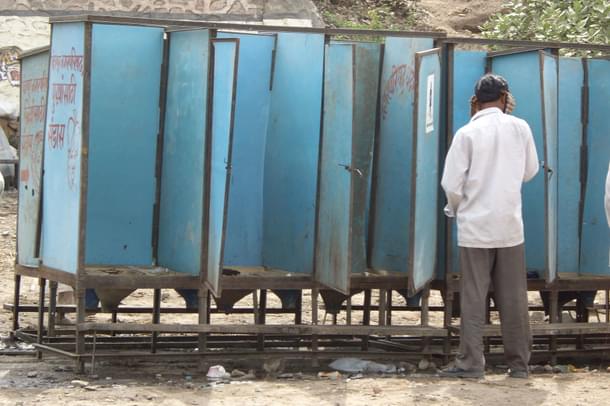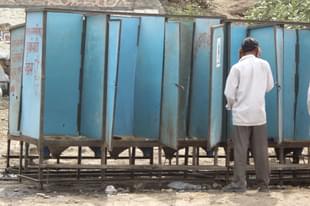Ideas
Two Things Necessary To End Manual Scavenging: Investing In Toilet Tech And Zero Tolerance For Dry Latrines In Households
Dr Subhash Chandra Pandey
Sep 14, 2021, 04:23 PM | Updated 04:23 PM IST
Save & read from anywhere!
Bookmark stories for easy access on any device or the Swarajya app.


Recently, the Madras High Court put the spotlight on the issue of ‘manual scavenging’ by directing all Municipal Commissioners to file written undertakings about this dehumanising pratice in their areas.
Manual scavenging means "manually removing, carrying, disposing of, or otherwise handling human excreta from insanitary latrines, open drains, gutters/sewers or septic tanks, pits, or public streets.
An insanitary latrine is a toilet not connected to any safe containment structure like a septic tank or twin pit. These are usually ‘Pit latrines’ or ‘Dry latrines’ not served by a flushing system.
In cities, the excreta flushed out from bathroom toilets travels to underground septic tanks and from there to municipal sewer pipelines. Manual scavengers usually use hand tools (buckets, brooms, tin plates and shovels) to transfer the waste into carts or baskets carried as head-load/backload. They need to enter septic tanks and gutters when sewer lines get clogged. They rarely have personal protective equipment: mask, face-shield, glove, goggle, hat, boots, apron, PPE kit — no such safety gear.
Septic tanks and gutters can be filled with methane and other toxic gases. Usually they throw a burning matchstick to check the presence of combustible methane but sometimes the test is not reliable and methane can erupt after they enter the pit.
Every year, dozens of manual scavengers die due to asphyxia caused by poisonous gases. What is most nauseating is that for these hapless workers, that is the only way to make a living.
Manual scavenging was banned 25 years ago with the passing of the Employment of Manual Scavengers and Construction of Dry Latrines (Prohibition) Act, 1993. The Act prescribes punishment to an employer who employs manual scavengers and also to those who construct dry latrines. The punishment prescribed is imprisonment for up to one year and/or a fine. In cases where the employees are the members of the Scheduled Caste or the Scheduled Tribe, the employers are also liable to prosecution under the Scheduled Castes and Scheduled Tribes (Prevention of Atrocities) Act, 1989.
The Prohibition of Employment as Manual Scavengers and their Rehabilitation Act, 2013 is wider in scope to include ban on use of human labour for direct cleaning of sewers, ditches, pits and septic tanks. Also, it lent greater focus on helping manual scavengers leave their traditional profession and get rehabilitation assistance to find alternative employment.
The Housing-Listing and Housing Census, 2011 showed that there were 26 lakhs insanitary latrines in India of which nearly a third were serviced manually.
In recent years, a massive campaign has been launched to construct flush latrines in every household as well as community toilets so as to declare the country free from the practice of defecation in the open areas. This massive construction activity together with proper water supply should have theoretically eradicated all dry latrines. However, the manual scavenging occupation persists mainly because of the continued presence of insanitary latrines requiring manual cleaning.
Further, the sewage systems in many cities are not fully amenable to mechanised cleaning, making manual intervention inevitable. Many cities do not have sewerage system for the whole city.
Sometimes, sewage lines are connected to storm water drains which get clogged and demand human intervention. Open drains are badly designed and allow people to dump all sorts of solid waste into them, which accentuates the problem. Improper disposal of items of personal hygiene clogs the drains which machines cannot clear. Lack of coordination between municipal bodies and Water/Sewerage Boards also contributes to the mess.
There is no reliable and comprehensive data as to how many dry latrines and how many active manual scavengers are there. In the Socio Economic Caste Census (SECC) 2011, as many as 1,68,066 rural manual scavenger households had reported themselves as engaged in manual scavenging.
The data compiled under the SECC is based on the declaration made by the household to the enumerator at the time of the census. The veracity of such claims has not been verified.
As per two countrywide surveys conducted in 2013 and 2018, the number of manual scavengers is estimated to be 63,246. The 2018 survey was carried out in 194 districts in 18 states.
Hence, the number is an underestimate. Under extant schemes, manual scavengers (both currently active and those who have left the job but are struggling to find gainful alternative employment) are supposed to be provided with some government rehabilitation — onetime cash assistance (OTCA) of Rs. 40,000, loans up to Rs.15,00,000 at concessional rate of interest and scholarship schemes for their children.
More than 91 per cent of 63,246 manual scavengers identified across the country (by March 2020) have been provided OTCA by February 2021.
Alwar was the first city in the country to be declared manual scavenging-free in April 2003, followed by Tonk in 2008.
I remember doing an audit on the subject in J&K in 2014. We found that out of 20.15 lakh households in Census, 2011, there were 1.79 lakh service latrines where night soil was removed by humans.
Even in 2014, only a few hundred manual scavengers were reported from some districts.
Elimination of manual scavenging is not just a legal and moral obligation but also something desirable and doable by using the right technologies.
Many countries use robots and non-robotic machines to clean sewers. It is catching up in India as well but at a very nascent stage. There are reportedly about 15 innovations to replace manual scavenging.
Hyderabad Metropolitan Water Supply and Sewerage Board is using 70 mini jetting machines that can access narrow lanes and smaller colonies to clear the choked sewer pipes.
In Thiruvananthapuram, a group of engineers has designed a spider-shaped robot that cleans manholes and sewers with precision.
BANDICOOT ROBOT 2.0 is a robotic machine engineered for cleaning any type of sewer manholes. It has a drone unit which will dive into the manholes for the cleaning operations or unblocking operations.
The drone unit is equipped with an extendable robotic arm with four degrees of freedom to perform grabbing, shovelling and unblocking actions inside the manholes.
The operator can control the drone unit by monitoring through a high definition display. The sensor-based feedback system allows the user to know the position of the robotic drone unit inside the manhole, enabling a surgical cleaning with high efficiency. (This is akin to image-guided surgery in humans.)
While technology is considered essential to end this scourge, focusing only on technological fixes to end manual scavenging will not work. The technologies will be mostly suitable outside households. For the household segment of the problem of manual scavenging, the only solution is zero tolerance for dry latrines in households. With government subsidy schemes in place, there should be no excuse for not converting existing dry latrines into flush latrines. However, the real problem is reliable water supply to the flush latrines.
Waterless toilets have been successfully used in commercial establishments, mostly in urinals. Railways have adopted waterless bio-toilets (where bacteria decompose human excreta rather than running water).
Developing affordable and effective waterless bio-toilets for home use should be an R&D priority area to deal with not just the problem of manual scavenging but also water conservation. Existing designs of flush tanks result in lot of wastage of water in urban households especially when there is a single water supply source for both drinking and sanitary use.
I try to reduce water wastage by putting some stone or water filled bottle in the flush tank. Similar contraptions can work till we can replace existing flush tanks with more water efficient ones. The US Environmental Protection Agency had revised in 2014 the specifications of flush tanks because the older, inefficient toilets used as much as 6 gallons per flush homes.
Technological advancements have allowed toilets to use 1.28 gallons per flush or less, while still providing equal or superior performance — 20 per cent less water than the federal standard of 1.6 gallons per flush.
EPA developed a ‘WaterSense label’ to be used on toilets that are independently certified to meet rigorous criteria for both performance and efficiency.
Popularising similar ideas of eco-friendly certifications/labelling in India should be a goal of construction the industry.
We need water-efficient flushing systems or effective/affordable bio-toilets everywhere, but more so in the household sector, to deliver twin benefits of sociological justice and restoration of ecological balance.
This post was originally published on Subhash Pandey's Facebook page and has been republished here with permission.





